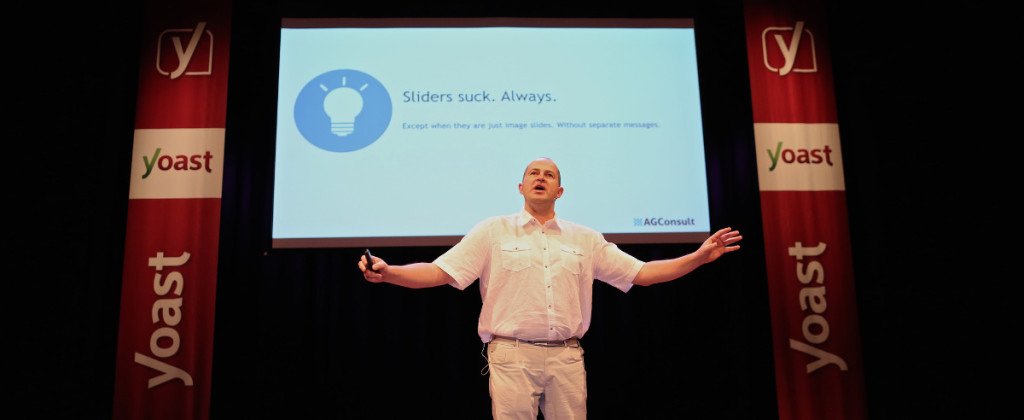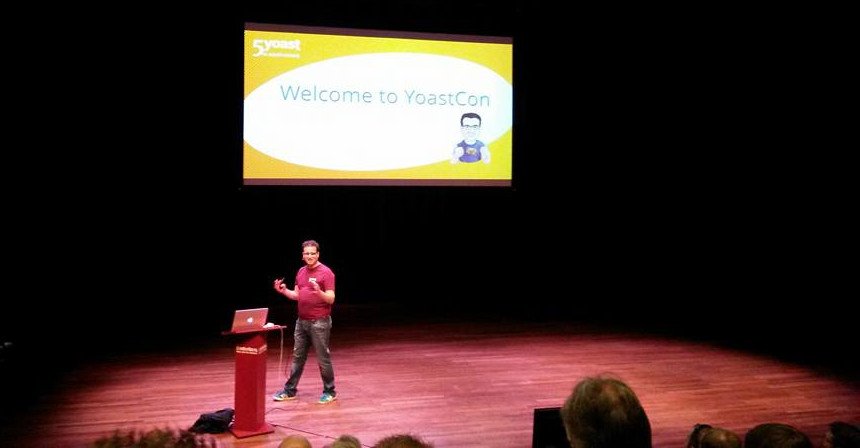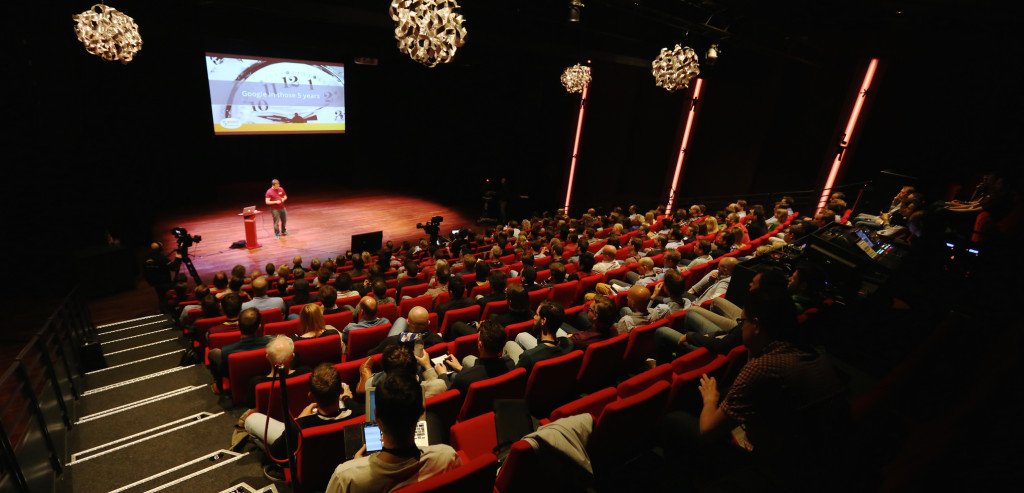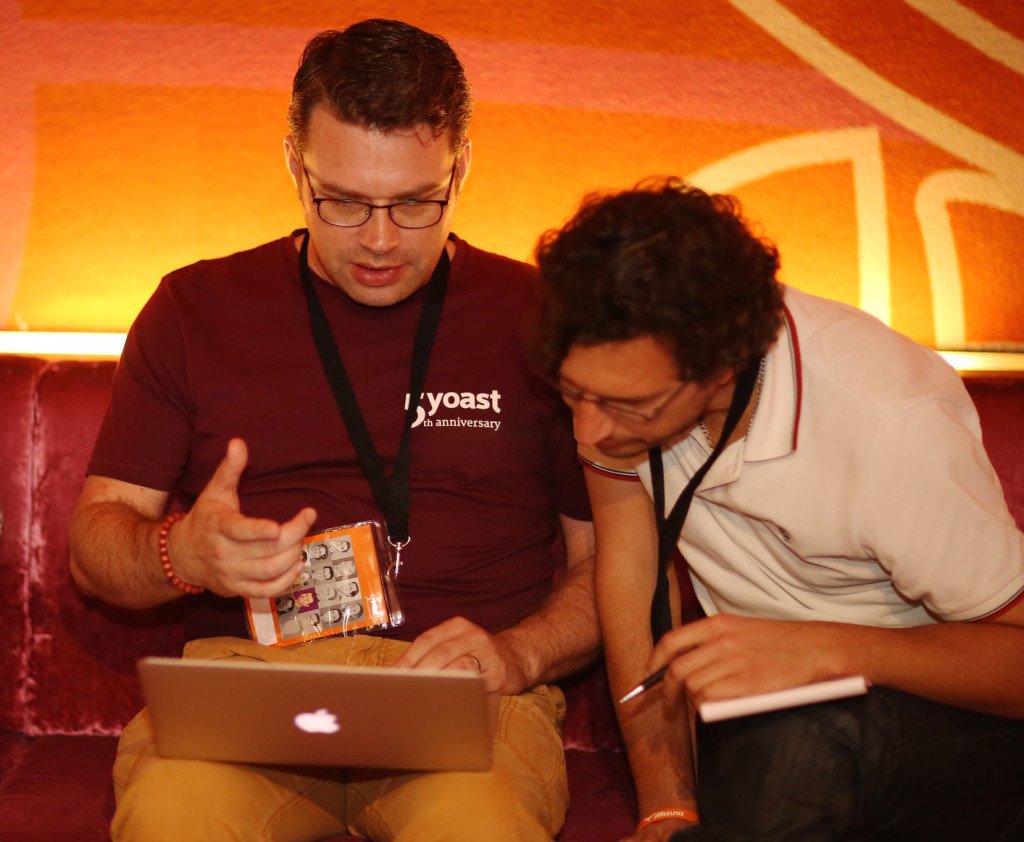Last week I got chance to participate to YoastCon, the conference organized by Yoast to celebrate the 5th anniversary of the company.
If you know WordPress, you know Yoast. It’s the company behind WordPress SEO, the most used SEO plugin, and other popular plugins. But not only that: Yoast offers website review service, SEO e-books, and will soon start an Academy that I hope will provide a certification – something that in my opinion the industry needs very much.
The event was held in Nijmegen, Netherlands (where the company is based) and I enjoyed every aspect of it.
Starting from the early morning car ride from Amsterdam with the guys from NexusThemes (their theme collection is impressive!) till the alcohol-fueled conversations at the final Dutch borrel with dudes like Danny van Kooten and Barry Kooij (Woothemes) and that American guy from Codeguard to whom I gave a million dollar idea. Oh yeah.
Here is a report with my random notes from the day and my takeaways.
Opening talk by Joost
What Joost himself introduced in the opening talk is the concept of holistic SEO based on four pillars:
- Design/Usability: a website must be appealing and clear to use.
- Technical details: such as speed, clean up of pages, maintenance of 404 and broken links, different content options.
- A good story: content must be created thinking ‘why talk about it?’.
- Security: an increasing important aspect of WordPress websites.
Rise of the machine – Marcus Tandler
Marcus speech is delivering a clear message:
Google is not a search company, is a machine learning company.
Every search we do on Google, email we receive on Gmail and action we take with Chrome is training Google’s Artificial Intelligence (AI).
He advocates the backlinks will soon become irrelevant and while a part of me really hopes so, isn’t something new and there are still plenty of websites ranking because of powerful backlinks out there.
I got to know that Matt Cutts, head of Google anti-spam team, is now on-leave and will probably come back with a new role. And Marcus presented a case study where successful ranking of long-term keywords caused his website to be promoted in high-competitive short-term keywords.
In the future Google will work on anticipating searched, proposing solutions to people depending on the context and location. Example: you’re leaving your office at 9pm, nothing planned in your calendar, so most likely you may want to eat a good pizza in the neighbor.
Information searches are more and more answered by Google directly (example: time in Los Angeles) while action searches take to the web (buy, learn, travel, fix…).
Marcus is founder of Onpage.org, a German company specialized in technical SEO.
The state of WordPress security – Tony Perez
Tony Perez from Sucuri (yeah, he’s the guy in the homepage picture) talked about how vulnerable our WordPress websites are.
Having worked for long years in the network security industry I was quite familiar with the concepts, but here are some notes anyway.
With popularity came exposure, and with exposure came financial return in attacking WordPress websites.
End-user is setup for failure in security out of the box.
The auto-update feature is based on the wrong premises: that a user can replace any file (has write permission) of the site. A better design would keep things more controlled and separated, but of course there’s a trade-off between simplicity of operations for end users and level of security.
Security issues are keeping enterprises and corporate away from WordPress.
He mentioned in the Q&A session that using SSL (https instead of http) is positive for SEO… that’s something I really have to investigate about.
I asked what’s the #1 change he recommend to implement on default WordPress installations and he replied with no doubt: 2-factors authentication.
Growth hacking tips that work on every website – Karl Gilis
Karl Gilis from AGconsult gave what for me was the most interesting presentation of the day, probably because I’m fascinated by conversion optimization and the lack of it 🙂
A/B testing is not the panacea:
- You need at least 400 conversions to declare a winner.
- Don’t start with small things (the button color for instance…).
- Don’t try any (stupid) idea it comes to your mind.
- Don’t copy others assuming it will work for you too.

He proceeded showing real examples of changes in websites and how they affected conversions:
- Sliders suck: big images in sliders are useless, better to use the space for the top products.
- Remove clutter: remove disturbing elements, have prices close to BUY buttons, keep checkout pages simple!
- Remove navigation menu from landing pages.
- Use bullet lists: they are far more readable and effective to convey the message.
- Add a reassuring message neat the call-to-action: avoid negativity (we NEVER SPAM you), stay positive (we guarantee your privacy).
- Green check marks are not as effective as they used to because over-utilized.
- Tell users what to do: use clear links like ‘details’, ‘read more’, ‘click to <action>’.
- Put the call-to-action where people sees it and at the bottom of the pages.
- Pay attention when using big headers and big photos.
- Use tools: Formisimo to analyze how forms are filled-in, HotJar for heatmaps and recordings.
- Use tools to ask customers “what’s the purpose of your visit?”.
- For web-shops, having in homepage categories instead of products generally works better.
- Make it easy to compare products, highlight the differences.
- Know what your customers want. Example: in a manufacturer website visitors are most likely looking for dealers.
After this presentation I run to sign-up to HotJar and I’m now addicted to session recordings.
Save yourself a million when you build your next site – Chris Lema
Chris is a big guy in every sense, and his presentation is a bit too American for my taste. I mean all the name dropping, all his ‘good friends’, and the money examples made to impress.
I’m hard to impress but never the less there were great takeaways and here are my notes.
Chris delivered a clear message: hope is not a strategy. Keep talking, keep learning.
He presented five examples of mistakes caused by hope-based strategies:
- Opt-in popups work, but move them towards the end of the user experience, when he decided to leave the website, rather than at the beginning when he/she doesn’t know you yet.
- Integrate stores in the site, don’t disrupt the customer experience sending them to a separate website.
- Don’t ignore indirect & offline revenue.
- Use email automation to ask many times. It’s becoming increasingly more difficult for high-targeted people to commit on the 1st interaction (commit to buy or just giving the email address).
- Use affiliate links from Amazon, not Bitly. Services like Bit.ly replace the affiliate IDs with their own!
Quick website review
During the day I also got chance to sit with Michael (from Yoast team) and have a quick website review during a coffee break. I let him check one of my websites. It was definitely a short session, but was nice to see how they first focus on usability and clear call-to-actions, before moving into technical checks.
And I got some good tips to work on.
The whole recording is available below, let me just add the times of the different presentations:
- 25:45 – Opening talk by Joost
- 43:51 – Rise of the machines byMarcus Tandler
- 1:56:35 – The state of WordPress security by Tony Perez
- 4:36:10 – Growth hacking tips that work on every website by Karl Gilis
- 5:47:56 – Save yourself a million when you build your next site by Chris Lema
A big congratulations goes out to Joost and his team, for the 5 years anniversary and for putting together such a great event!
A new logo, company style and plenty of goodies completed the day.



Hi Daniele
Here is a good reference link that talks to Google’s push to get HTTPS everywhere.. https://googlewebmastercentral.blogspot.cz/2014/08/https-as-ranking-signal.html and how they are planning to use it for rankings..
Cheers (gut on website)
Tony
Thanks Tony for passing by!
Interesting, I found this research https://blog.searchmetrics.com/us/2014/08/29/https-vs-http-analysis-do-secure-sites-get-higher-rankings/
showing no advantages but it’s almost one year old.
I wonder if it’s more relevant now.
Hey Daniele
Oh yes, that doesn’t surprise me at all. It takes time for this stuff to take affect, but it shows a direction and intent. It however has had an impact on what endusers believe and has brought a sudden surge in the need to have “SSL” on all sites. It’s also brought about this perception that having SSL all of a sudden makes your website secure, which isn’t the case. That was more the direction I was going with it…
Tony
Happy that you liked my talk.
Can you link to my Twitter @agconsult or my website http://www.agconsult.com?
Thanks
Karl
Why not both? Done! 🙂
Thanks Karl for reading
Why are you so picky Karl!!!!
Damn it man!!!
Tony
Hi Daniele,
I was there too! Shame me didn’t run into each other. Thanks for the write up, better readable then my notes!
That’s serious coincidence! Where are you based?
Belgium, close to Ghent
Hey Daniele, nice meeting you there, and great summary of the conference; only thing you forgot was the emergency stop at the McDonalds on the way back 😉
ahah that sounds worse than it was! But thanks for stopping 🙂